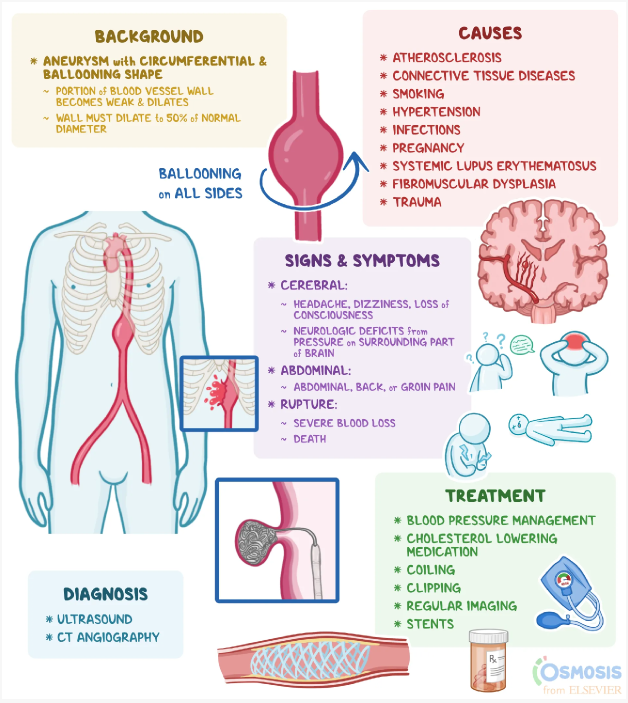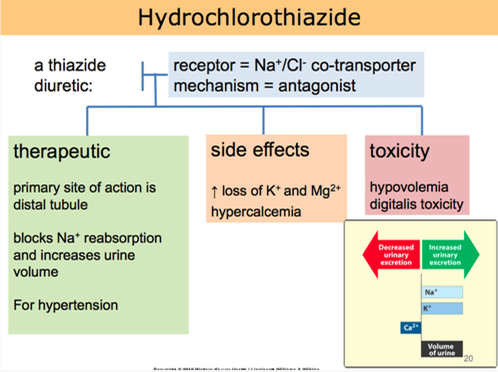The client is diagnosed with an abdominal aortic aneurysm. Which statement would the nurse expect the client to make during the admission assessment?
“I have stomach pain every time I eat a big, heavy meal."
“I don't have any abdominal pain or any type of problems."
“I have periodic episodes of constipation and then diarrhea."
“I belch a lot especially when I lay down after eating"
The Correct Answer is B
Abdominal aortic aneurysms (AAA) often do not present with specific symptoms in the early stages. It is not uncommon for individuals with AAA to be asymptomatic or have vague symptoms. Therefore, the absence of abdominal pain or any problems related to the abdomen is a common finding during the assessment of a client with an abdominal aortic aneurysm.
Let's briefly review the other statements:
"I have stomach pain every time I eat a big, heavy meal": This statement is more suggestive of gastrointestinal issues such as indigestion or acid reflux rather than specifically related to an abdominal aortic aneurysm.
"I have periodic episodes of constipation and then diarrhea": This statement may indicate gastrointestinal issues, but it is not a typical symptom associated with an abdominal aortic aneurysm. AAA is primarily related to the aorta, the main blood vessel in the abdomen, and its symptoms are not directly linked to bowel function.
"I belch a lot, especially when I lay down after eating": This statement suggests gastrointestinal symptoms such as acid reflux or gastroesophageal reflux disease (GERD). While these symptoms may be unrelated to the abdominal aortic aneurysm itself, they can coexist with other conditions.

Nursing Test Bank
Naxlex Comprehensive Predictor Exams
Related Questions
Correct Answer is D
Explanation
Hydrochlorothiazide is a diuretic medication commonly prescribed for hypertension. It works by increasing urine output, which helps to reduce fluid volume and lower blood pressure. Taking the medication in the morning is beneficial because the increased urine production during the day can help prevent nighttime disruptions due to frequent urination.
Let's go through the other statements and explain why they are not accurate:
"I will not take this medicine when my blood pressure is okay":
This statement indicates a misunderstanding about the purpose of hydrochlorothiazide. It is important to take prescribed medications consistently, even when blood pressure readings are within the normal range, as they are intended to help maintain blood pressure control.
"I will check blood pressure in both arms and legs before taking the drug":
Checking blood pressure in both arms and legs is not directly related to hydrochlorothiazide use. Blood pressure should be monitored regularly, but it is not necessary to perform these measurements specifically before taking the medication.
"I will decrease potassium foods such as bananas in my diet":
Hydrochlorothiazide can cause potassium loss as a side effect. However, reducing potassium-rich foods without healthcare provider guidance may not be appropriate. It is important for the client to discuss dietary adjustments and potassium supplementation with their healthcare provider if needed.

Correct Answer is A
Explanation
The nurse should assess the client with a blood pressure of 190/92 mm Hg who reports chest pain first. Chest pain can be a symptom of myocardial ischemia or a heart attack, which requires immediate attention. The combination of high blood pressure and chest pain is concerning and may indicate acute coronary syndrome. Prompt assessment and intervention are crucial to evaluate the cause of the chest pain and initiate appropriate treatment.
A client with a blood pressure of 190/104 mm Hg who has sinus tachycardia: While sinus tachycardia may indicate increased heart rate, it does not necessarily require immediate assessment unless other concerning symptoms are present. However, the nurse should address the elevated blood pressure in a timely manner.
Intermittent claudication refers to leg pain or discomfort during physical activity due to reduced blood flow. While it is important to assess and manage this symptom, it is not typically considered an urgent condition requiring immediate assessment compared to chest pain.
The client scheduled for a stress test may have elevated blood pressure, but if they are stable and not currently experiencing symptoms, they may not require immediate assessment compared to a client with chest pain.
Whether you are a student looking to ace your exams or a practicing nurse seeking to enhance your expertise , our nursing education contents will empower you with the confidence and competence to make a difference in the lives of patients and become a respected leader in the healthcare field.
Visit Naxlex, invest in your future and unlock endless possibilities with our unparalleled nursing education contents today
Report Wrong Answer on the Current Question
Do you disagree with the answer? If yes, what is your expected answer? Explain.
Kindly be descriptive with the issue you are facing.
